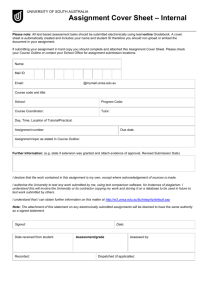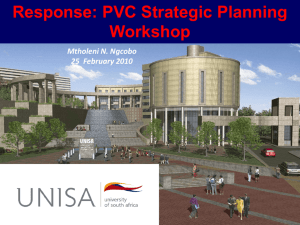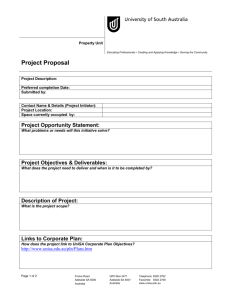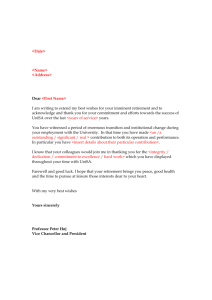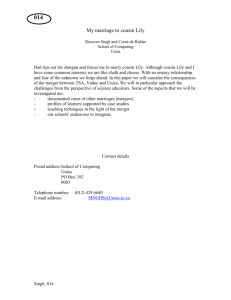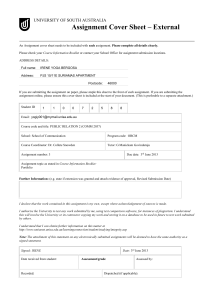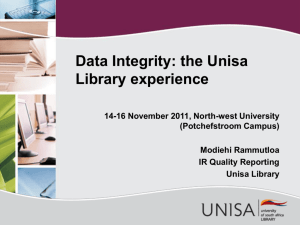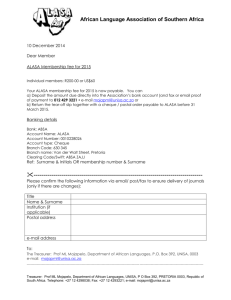Judy Henning (MS PowerPoint , 8892kb)
advertisement
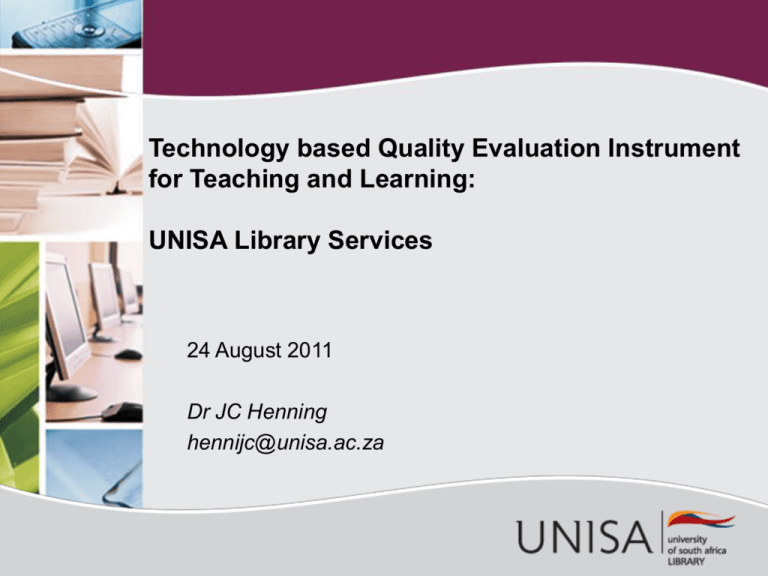
Technology based Quality Evaluation Instrument for Teaching and Learning: UNISA Library Services 24 August 2011 Dr JC Henning hennijc@unisa.ac.za CONTENTS • Background • Context – Open Distance Learning (ODL) – Libraries in ODL • Integrated Quality Management and Assurance System • Conclusion UNIVERSITY OF SOUTH AFRICA Unisa worldwide influence EUROPE AMERICAS 222 ASIA 386 900 AFRICA 22 000 SOUTH AFRICA OCEANIA 32 291 460 2010 4 UNISA LIBRARY CONTEXT • UNISA vision: “Towards the African University in the service of humanity” • UNISA 2015 revisited: an agenda for transformation / UNISA 2011 operational plan – 7 Objectives: Library - IR Repository / College Teams / Research space / Regional Libraries • Comprehensiveness – Refers to a range of qualifications represented on the HEQF. These qualifications cater to the diverse needs of students and society from skills based vocational training to advanced theory based research degrees • ODL and enhanced learner services – – – Postal services Search services Online services • International guidelines for distance education libraries – Guidelines on responsibility / Human resources / financial resources UNISA LIBRARY • • • • • • • • • 9 branches in South Africa and 1 in Ethiopia 2 mobile libraries serving rural areas Services on mobile devices Postal service and e-reserves MyUnisa – Integrated services in courses College Teams 2, 618 920 items 30 000 e-books 62 189 e-journal titles LIBRARY SERVICE CHARTER • • • • Purpose – We commit ourselves to quality library and information service to all users. Context – We support of the Unisa Service Charter. Intent – We value your success by providing high quality library and information services. – We strive to be your information partner of choice. – We commit to fast, friendly and efficient information services and resources. – We undertake to serve your information needs. – We believe in mutual respect . Our pledge. – We want to be your preferred information partner. INTEGRATED QUALITY MANAGEMENT AND ASSURANCE • Statutory responsibility – HEQC – Responsibility to deliver high quality learning experiences & responsive to ODL requirements – Define ODL quality criteria and set relevant standards – Monitor and evaluate quality of modules – Unisa PQM large numbers of modules – resources, turnaround time frames & paper based • Integrated Quality Management and Assurance Framework (IQMAF) – Supportive environment to define expectations and standards Unisa 2015 Revisited Quality Assurance Policy Integrated Quality Management and Assurance Framework Quality Management Teaching and Learning •All institutional policies, processes, procedures and systems •Identified criteria •Agreed standards •Benchmarks Research and Postgraduate Education •All institutional policies, processes, procedures and systems •Identified criteria •Agreed standards •Benchmarks Community Engagement •All institutional policies, processes, procedures and systems •Identified criteria •Agreed standards •Benchmarks Quality Assurance External Institutional Audits and Programmes Reviews Teaching and Learning •Quality Evaluation Instrument (QEIfor TL) •Guidelines for internal and external reviews Research and Postgraduate Education •Quality Evaluation Instrument (QEIfor RPE) Community Engagement •Quality Evaluation Instrument (QEIfor CE) Quality Promotion and Capacity Development Quality impact assessment to achieve performance goals and effective student learning Quality Assurance System Quality Reviews Teaching and Learning •Unisa Quality Evaluation System •Review model (Inc protocols and schedule External Institutional Audits Research and postgraduate education •Unisa Research and Postgraduate Evaluation Model Step 2: PQM analysis and review (PQM relevance, financial viability, market analysis, national enrolment planning guidelines) Step 1: Evaluate and quality assure the learning experience through UQES Step 3: Module planning and document preparation for approval Step 4: Design and develop learning material Step 6: Learning facilitation Step 5: Planning, Coordination, Print and Production Community engagement •Unisa CE Evaluation Model Quality Promotion and Capacity Development Unisa Curriculum Policy and the Framework for a team approach INTEGRATED QUALITY MANAGEMENT AND ASSURANCE (2) • Quality Evaluation Instrument (QEI) – Teaching and Learning as phase 1 – Comprehensive Technology enhanced / innovative web enabled system – Aligned with curriculum / module development cycle to effect continuous improvement strategies – Provide strategic information for the PQM and curriculum renewal exercises. – Evaluate student’s total learning experience, ensuring ODL quality of the design development and delivery of approved modules – Principles of HEQC and Nadeosa QEI TEACHING AND LEARNING • Objectives – Integrated – evaluate whole learning experience (systems driven ODL) – all areas in value chain – Integration and alignment – institutional frameworks and policies – Accommodate wider range of approved modules – Impact on improvements to the design, development of learning materials and delivery timely – Evaluate quality directly rather than satisfaction through a participatory and stakeholder driven approach – Ensure indicators are underpinned by internationally recognized ODL standards QEI TEACHING AND LEARNING • Advantages – Quality surveys in shorter period by simulating stakeholder interviews such as participating in a quality audit interview of programme review process – Produce equivalent and triangulated outcomes in more cost-effective manner – Reduce resourced required from a paper-driven process (large part or review is automated and reports generated through web-based technologies – Capacity to facilitate the review of all modules within a given seven-year cycle in a manner that provides quality inputs to curriculum renewal cycles QUALITY EVALUATION INSTRUMENT: TEACHING AND LEARNING • Dimensions to ensure quality service in ODL – Planning resource allocation and quality management – Design and development of learning material – Delivery of quality learning experience CRITERIA AND STANDARDS • Criteria – Aligned with HEQC and NADEOSA • Standards – Identify current processes, systems, policies, procedures and services – Define quality criteria, standards and translate into quality assurance statements – Consult and validate – Weightings per criteria and stakeholder groups – Evaluation process and reports STAKEHOLDER GROUPS Weightings to three evaluation areas and four stakeholder groups: pair-wise comparison analysis LIBRARY QUALITY ARRANGEMENTS • Unisa Library Quality Committee – – – – Oversee, coordinate and monitor quality assurance Implementation of the Library Quality Improvement Plan Preparations for quality assurance reviews Task analysis of library business processes • Integrated in Unisa Quality Evaluation Instrument – Library Quality Assurance Framework – Quality standards for each segment that contributes to Teaching and Learning THANK YOU / QUESTIONS
